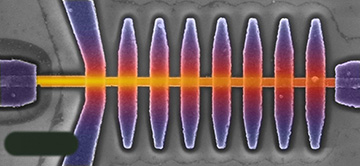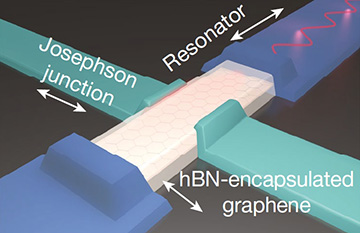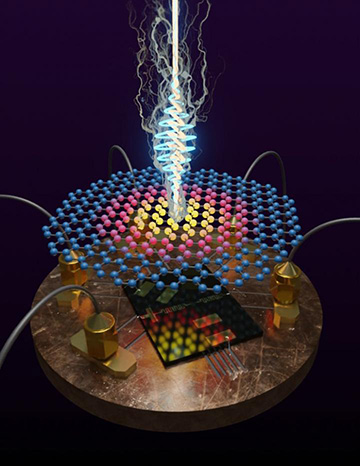![]()
Artist’s rendering of the graphene nanobolometer designed by the Aalto University–VTT group. It’s one of two such devices that use the properties of graphene (hexagonal lattice) to boost sensitivity and reduce response time for sensing microwave radiation. [Image: Heikka Valja, CC-BY 4.0]
Two research teams—one based at Aalto University and the VTT Technical Research Center in Finland, and one a multinational group comprising institutions in the United States, Korea, Spain and Japan—have reported designs for chip-scale microwave detectors that bulldoze through the speed and sensitivity limits of previous similar devices (Nature, doi: 10.1038/s41586-020-2753-3, 10.1038/s41586-020-2752-4). In both experiments, the secret weapon is graphene, the atomically thin, 2D form of carbon whose exotic properties have tantalized the physics community since its discovery in the early 2000s.
Sensitive, compact and fast-response-time microwave detectors such as these could have applications in a range of areas, particularly precision radio astronomy. But the two research groups behind the new work also have their eyes on an even bigger prize: creating nanoscale devices that can sense the energy of single microwave photons, and thus help in the commercialization of quantum computers.
Measuring photon power via temperature shifts
The devices in question are bolometers, which measure the energy of incident radiation through its heating effects. When an incident photon is absorbed by the bolometer material, the absorbed power infinitesimally raises the temperature. The temperature change, in turn, slightly changes the resistance of the device, and the resulting voltage shift across the bolometer can be read out and related directly to the power of the incoming photon.
In recent years, the capabilities of bolometers have expanded dramatically, even as research teams have shrunk the devices down to the nanoscale. Indeed, the two are related, since making a bolometer smaller effectively reduces its heat capacity and thus boosts its thermal response. For example, almost exactly a year ago, the Aalto–VTT group behind one of the two bolometers in the new work had reported a bolometer fashioned from a 200-nm-wide gold nanowire that could resolve almost unspeakably subtle energy changes at the scale of zeptojoules (zJ, 10–21 J).

Last year, the Finland team behind one of the new studies unveiled a nanoscale bolometer consisting of a thin gold nanowire crossed by superconducting aluminum islands. [Image: Roope Kokkoniemi/Aalto University]
Needed: Sensitivity with speed
While sensitive bolometers have carved out a place in infrared imaging and radio astronomy, thus far they have not had quite the right combination of properties to work as single-photon microwave detectors in quantum computers. That application requires both sensitivity (the ability to resolve the energy of a single microwave photon) and speed (a thermal time constant on the order of hundreds of nanoseconds), to enable repeated, delicate quantum-state measurements at an appropriately rapid clip.
Researchers have demonstrated nanobolometers of adequate sensitivity and very low power consumption. But the devices have been orders of magnitude too slow to serve as detectors in quantum computing. As a result, the superconducting quantum computers built thus far have had to rely on much larger, voltage-based single-photon detectors that tend to be power-hungry and difficult to scale.
Fast heater
To build a nanobolometer that would be both sensitive and fast enough for the job, both of the research teams behind the newly reported work focused on the potential of graphene, the 2D material whose discovery snagged the 2010 Nobel Prize in physics. Among other things, graphene has an energy band structure in which the valance and conduction bands meet in a single point (the so-called Dirac point) in energy–momentum space. That makes the material a perfect semimetal with some remarkable electronic properties.
Most important for the current case, graphene’s unusual band structure gives the 2D material an extremely low specific heat. Thus a small ping of incident energy quickly gives rise to a big temperature change—and the material just as quickly cools down again afterward.
SGS junctions
While the detailed designs of the two groups’ bolometers are different, both of them center around the use of a superconductor–graphene–superconductor (SGS) junction to leverage the 2D material’s speed and sensitivity advantages.
The Finland team’s design ties the SGS junction to capacitors to form a temperature-dependent inductor–capacitor (LC) oscillator. The resonance frequency of the oscillator varies depending on the incoming microwave radiation absorbed by the graphene, allowing the microwave power to be read out.

Diagram of the bolometer design of the multinational group, which consists of a graphene Josephson junction, integrated into a microwave circuit. [Image: Harvard-ICFO-MIT-BBN Technologies-NIMS]
The multinational team created an SGS Josephson junction embedded in microwave resonators. In this setup, the resonator is used for microwave coupling to the graphene, and the Josephson junction allows DC readout from the bolometer.
At the quantum-information threshold
The Finland team reported that its device could sense microwave radiation down to a noise-equivalent power (NEP) of 30 zJ/Hz½, with a measured thermal relaxation time as low as 200 ns. That’s two orders of magnitude faster than the equally sensitive gold-nanowire bolometer unveiled by the team last year—fast enough, according to the researchers, to put the device at the threshold for applications in quantum circuit electrodynamics.
The measured NEP of the multinational team’s device, at 700 zJ/Hz½, was an order of magnitude larger than the Finland team’s, suggesting lower sensitivity. On the speed front, however, the multinational team’s calculations suggest that the thermal time constant of its device could be three orders of magnitude faster than that of the Finland team’s device (though the value for the multinational team’s device was calculated rather than measured).

Artist rendering of a microwave bolometer based on a graphene Josephson junction. [Image: Graham Rowlands, Raytheon BBN Technologies]
Both teams are now hard at work to optimize their bolometers for use as microwave single-photon detectors, particularly for superconducting-circuit quantum computers, such as the ones being developed by Google and IBM. “Bolometers are now entering the field of quantum technology,” according to Mikko Möttönen, who led the Aalto-VTT project, adding that their first application might be “in reading out the quantum information from qubits.”
The first author on the multinational effort, Gil-Ho Lee of the Republic of Korea’s Pohang University of Science and Technology (POSTECH), also has big expectations for that team’s device in quantum information. He suggests in particular that the bolometer could help make quantum computers more scalable, and thus more commercially viable.
“This study is significant in that it has established a scalable technology to enable the next-generation quantum devices,” Lee maintained in a separate press release. “We expect this technology to maximize the measuring efficiency of quantum computing and drastically reduce the indirect resources to enable large-scale quantum computers that will be of great use.”
In addition to researchers at POSTECH, the multinational effort also included contributions from scientists at Harvard University MIT and Raytheon BBN Technologies, USA; ICFO in Barcelona, Spain; and the National Institute for Materials Science, Tsukuba, Japan.
